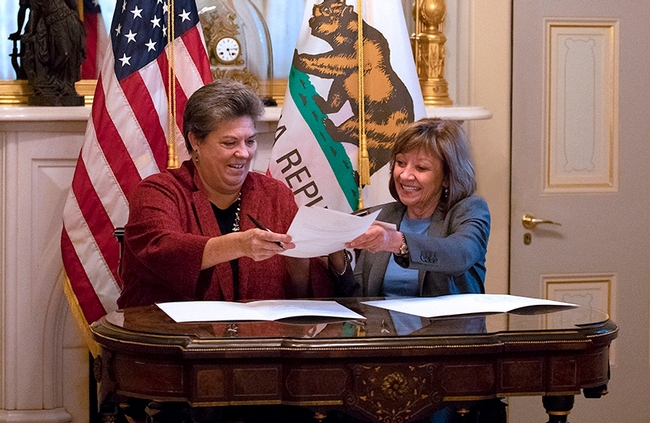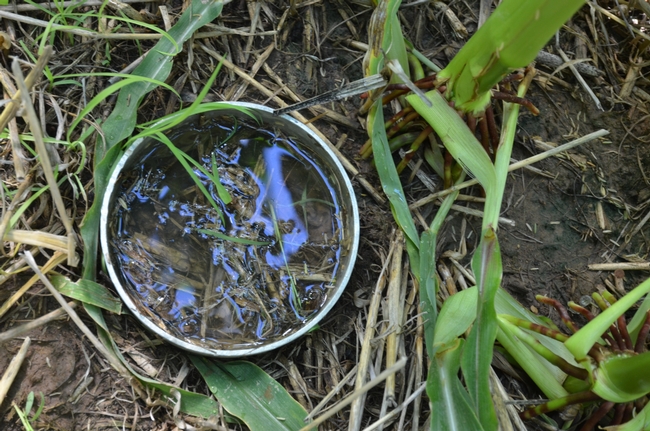
Posts Tagged: Dan Munk
CDFA and UC ANR join forces to advance climate-smart agriculture in California
California Secretary of Agriculture Karen Ross and UC Agriculture and Natural Resources vice president Glenda Humiston signed a memorandum of understanding in Sacramento Oct. 26 to initiate a new partnership to advance climate-smart agriculture in California.
This partnership will provide $1.1 million to hire 10 UC Cooperative Extension community education specialists who will be deployed to 10 counties statewide to assist and encourage farmers to participate in CDFA programs aimed at increasing adoption of smart farming and ranching practices.
“Agriculture is an important part of the climate solution,” Ross said. “This funding enables CDFA and UC ANR to partner with farmers to scale-up climate smart agricultural practices.”
The new program is funded by California Climate Investments dollars through the Strategic Growth Council (SGC),
“Farmers and ranchers are key to carbon sequestration and a sustainable California,” said SGC chair Ken Alex. “The Strategic Growth Council is pleased to fund this partnership for smart agricultural practices.”
The partnership is focused on implementing on-farm solutions to improve soil health, nutrient management, irrigation management, on-farm composting and manure management – smart farming practices that reduce greenhouse gas emissions into the atmosphere.
- State Water Efficiency and Enhancement Program
- Healthy Soils Program
- Alternative Manure Management Program
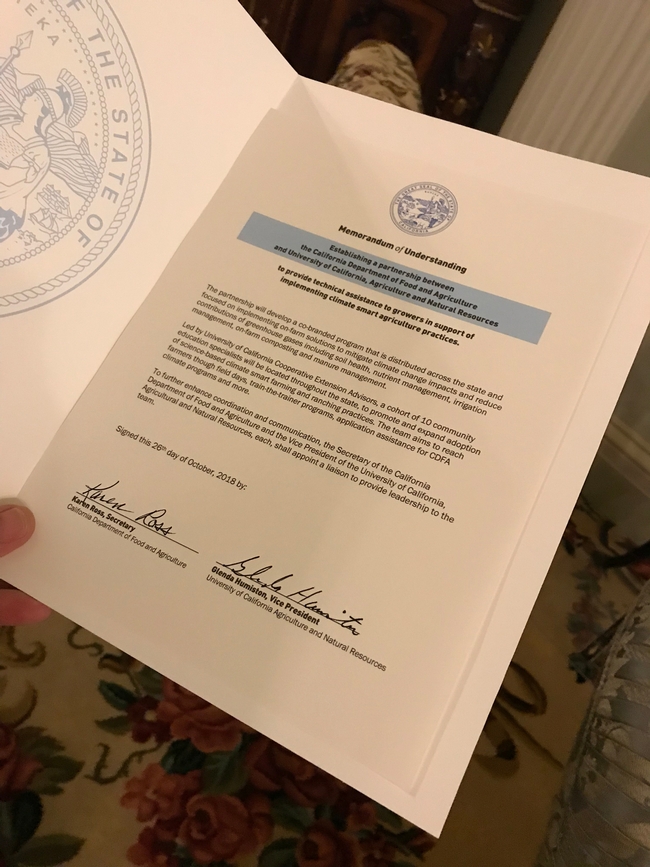
The 10 new education specialists will serve in Mendocino, Glenn, Yolo, San Joaquin, Merced, Kern, Imperial, San Diego, San Luis Obispo and Santa Cruz counties.
Three UCCE advisors will mentor and assist the new educators: water quality and management advisor Laurent Ahiablame, based in San Diego County; area dairy advisor Betsy Karle, based in Glenn County; and irrigation and cotton advisor Dan Munk, based in Fresno County.
In addition to working with the new educators, the UCCE advisors conduct research on farming and ranching practices that boost efficiency and protect the climate, therefore serving as a conduit between discovery and implementation.
“This is a great opportunity to really support growers find the right balance between food production and effective management of natural resources,” Ahiablame said. “With the 10 community education specialists we will be one step closer to the producers across the state. I look forward to the opportunity to mentor these specialists, who in turn will be making direct impacts on the community.”
Karle said she was interested in participating in the program as a way to encourage dairy operators to try practices they are interested in but consider too costly.
“I've worked here locally with dairy producers who wanted to implement practices but need financial assistance in order to make it feasible,” Karle said. “They need assistance in the grant application process and technical support to make changes on their farms.”
Doug Parker, director of the UC California Institute for Water Resources, is the UC ANR point of contact and liaison with CDFA. To contact Parker, email doug.parker@ucop.edu.
Researchers see more overhead irrigation in California’s future
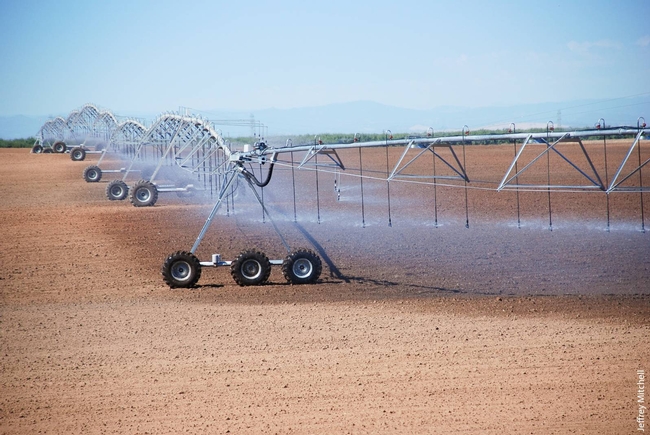
That is beginning to change.
UC Cooperative Extension and Fresno State agricultural production scientists researched overhead irrigation at the UC West Side Research and Extension Center for five years, growing wheat, corn, cotton, tomato, onion and broccoli and comparing them with crops produced under furrow and drip irrigation. With all of them except tomato, overhead irrigation led to similar or increased yields, according to the scientists' report published in the current issue of California Agriculture journal.
“Overall, we are very encouraged by these results, and they reflect the experiences that many California farmers have recently been having with overhead irrigation systems,” said lead author Jeff Mitchell, UC Cooperative Extension specialist. “We've confirmed that overhead irrigation systems work in California. We also concluded that there are opportunities to get even better results with more research and experience, particularly when overhead irrigation is coupled with practices that preserve crop residues and rely on reduced tillage.”
The article co-authors are Anil Shrestha, weed scientist at Fresno State; Joy Hollingsworth, UCCE staff research associate; and Dan Munk, Kurt Hembree and Tom Turini, UCCE advisors in Fresno County.
The tomato yields under overhead irrigation were disappointing, particularly since tomatoes have a prominent role in many Central Valley annual crop rotations.
“This isn't a simple process,” Mitchell said. “You can't just turn it on and let it go. It will require focused and dedicated farmer and researcher attention and innovation to solve.”
The authors are working with a team of Central Valley tomato farmers, processors, irrigation experts and research colleagues to improve overhead irrigation management in tomatoes. They are encouraged by the success of Walnut Grove farmer Michael Boparai, who achieved profitable processing tomato yields with overhead irrigation.
Overhead irrigation systems were invented more than 60 years ago. They now irrigate 50 percent of total U.S. farm irrigated acreage. In Nebraska, 87 percent of irrigated land is under overhead systems. By contrast, in California overhead systems irrigate only 150,000 acres, just 2 percent of the state's irrigated farmland.
Mitchell and his co-authors outlined several factors that contributed to its slow rate of adoption in California:
- Early adopters ran into serious problems, giving the systems an undeserved bad reputation that persists even though in recent years California farmers are using the systems successfully.
- Center pivot systems typically leave the corners of the field unirrigated, which can reduce production.
- Purchase and installation cost of the overhead system is substantially higher than furrow irrigation.
However, the UC and Fresno State research has shown many advantages.
- Overhead irrigation can be managed remotely and automatically.
- The system can accommodate different terrain and soil types.
- Overhead systems requires less maintenance than drip systems in terms of avoiding clogging of emitters and repairing leaks.
- Overhead irrigation may also help with salinity management by uniformly leaching salts from a crop's root zone.
- Precision irrigation, including overhead systems, are becoming ever more critical with coming groundwater regulations, surface water cuts and the increasing cost of water for farmers in California.
A significant advantage of overhead irrigation is its compatibility with other farm management technologies that optimize the farming system and reduce costly inputs, including water, fuel, labor and fertilizer.
“We're committed to continuing our work on the whole package – reduced tillage, preserving residue, improving water infiltration, improving soil water-holding capacity and increasing productivity uniformity – a system that we refer to as conservation agriculture,” Mitchell said. “We are working to encourage adoption of conservation agriculture in crops where viability of the system is well established, and facilitate the research and innovation needed to optimize conservation agriculture production in additional crops.”
UC scientists helping farmers reduce water needs
Rain in December raised hopes for an end to the California drought, but storms have stayed away since the New Year began. January 2015 is shaping up to be the driest January since officials began keeping records 137 years ago, according to the National Weather Service.
California's continuing water crisis is leading to decreased and more variable water supplies for San Joaquin Valley farmers, and the region's forage production sector is being hit particularly hard.
“Corn silage and alfalfa have traditionally used lots of water and current and future water restrictions are forcing many farmers to rethink their forage production strategies,” said Jeff Dahlberg, UC Cooperative Extension specialist. “I know of one dairy that had to cut-off their summer irrigations of alfalfa to get their corn silage done.”
To help the agriculture industry make do with less water, a team of UC researchers began a long-term research project last year by growing alfalfa, sorghum and corn under a state-of-the-art center pivot irrigation system. The system, donated by industry partners, is installed at the UC West Side Research and Extension Center near Five Points. Reinke Inc. donated the center pivot, Senninger Irrigation donated nozzles, and Rain for Rent created the infrastructure that gets water and power to the 16-acre research plot.
“We see tremendous possibilities for overhead irrigation in cotton, alfalfa, corn, onions and wheat production,” said Jeff Mitchell, UC Cooperative Extension specialist and the project lead. “There is also great potential for overhead irrigation in California's $5 billion dairy industry for more efficiently producing feed crops like alfalfa, corn and sorghum.”
All aspects of production – including irrigation system performance, crop growth and development, weed control, water application, and economic viability – are being monitored by researchers from UC Cooperative Extension, Fresno State University and UC Davis, plus farmer cooperators and industry partners.
The primary focus of the study is comparing regular irrigation levels with regulated deficit irrigation, a system in which water is withheld at certain times in crop development in order to minimize crop losses even when water is short.

The researchers will apply small, precise amounts of water during the vegetative growth stage for sorghum and both immediately before and after monthly harvests and during the mid- to late-summer period for alfalfa when San Joaquin Valley productivity typically is reduced under flood irrigation.
“We expect to produce marketable and economic yields for sorghum using 25 percent less water as has been achieved under pivots in Texas and similar increases in crop water productivity for alfalfa,” Mitchell said. “This work will inform and improve future water management strategies in California.”
Overhead irrigation systems, such as center pivot systems, are the most prevalent form of irrigation nationwide; however, they have not been widely adopted in California to date. Recent technological advances in overhead irrigation – which allows integration of irrigation with global positioning systems (GPS) and management of vast acreage from a computer or smart phone – have boosted farmers' interest in converting from gravity-fed surface irrigation systems, which are still used on 5 million acres of California farmland.
The research is funded in part with a grant from the UC California Institute for Water Resources. In addition to Dahlberg and Mitchell, UC Cooperative Extension alfalfa specialist Dan Putnam and UCCE advisor in Fresno County Dan Munk are collaborators on the project.
An initiative to improve California water quality, quantity and security is part of the UC Division of Agriculture and Natural Resources Strategic Vision 2025.

The center pivot system at the UC West Side Research and Extension Center before crops were planted.
Too wet outside to work? Watch a drought video

“California will need about 150 percent of normal rainfall this winter to end the drought,” said Doug Parker, director of UC California Institute of Water Resources. “Although the rains have come, we can't afford to let our attention drift away from carefully managing our water supply.”
The UC California Institute of Water Resources, with support from the California Department of Water Resources, has recorded presentations by scientists in the UC system and other organizations on a variety of topics related to water management and drought. “Insights: Water and Drought Online Seminar Series” is accessible by computer or mobile device.
The online seminars enable UC Cooperative Extension and the other scientists to share their knowledge with a larger audience than those who can attend meetings in person, said Daniele Zaccaria, UC Cooperative Extension specialist in agricultural water management in the Department of Land, Air and Water Resources at UC Davis.
“Farmers, landscape professionals, land managers, irrigation consultants, resource managers from water districts and others can view the half-hour video presentations on YouTube whenever it is convenient for them, obtaining science-based information that stems from applied research conducted by several scientists over the last 10 to 15 years,” said Zaccaria, who coordinates the speaker series.
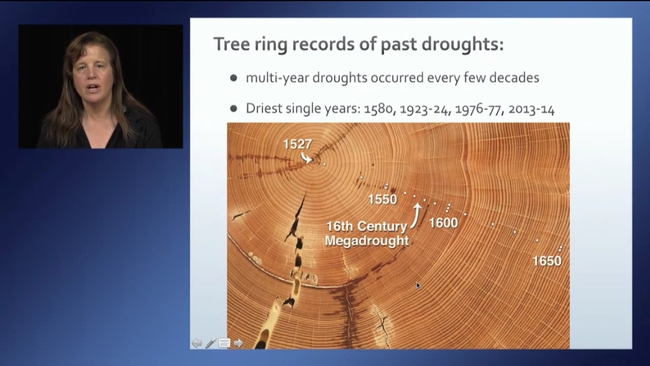
Currently 39 videos addressing drought and water management in different settings are available, and more talks will be added in the coming months. The videos are also being used by Cooperative Extension in other states and have been viewed hundreds of times. “Groundwater and surface water interactions under water shortage,” by Thomas Harter, UC Cooperative Extension specialist in the Department of Land, Air and Water Resources at UC Davis, has been viewed nearly 1,400 times and “Climate change and paleoclimatology: 2013/2014 in perspective” by Lynn Ingram, professor in the Department of Earth and Planetary Science at UC Berkeley, has been more than 800 times.
The following titles have recently been added:
Water resources management in the Pajaro Valley, California
Brian Lockwood, senior hydrologist, Pajaro Valley Water Management Agency
Managing corn under California's drought conditions
Mark Lundy, UC Cooperative Extension advisor in Sutter, Yuba and Glenn counties
Droughts, climate change, and dams: Reconciling a future for California's native inland fishes
Peter Moyle, professor in the Department of Wildlife, Fish & Conservation Biology at UC Davis
Managing landscapes on limited water
Loren Oki, UC Cooperative Extension specialist in the Department of Plant Sciences at UC Davis
Drought - An insidious stress on wildlife
Greg Giusti, UC Cooperative Extension advisor, forests and wildland ecology in Mendocino County
Agricultural water management practices under limited water supply: Lessons from recent droughts
James E. Ayars, agricultural engineer, USDA-ARS
Soil moisture monitoring and utilization during a drought
Dan Munk, UC Cooperative Extension advisor, irrigation, soils and cotton in Fresno County
Land subsidence along the Delta-Mendota Canal and neighboring areas
Michelle Sneed, California Water Science Center, US Geological Survey
How to save water and beautify your landscape ... the sustainable way
Janet Hartin, UC Cooperative Extension advisor, environmental horticulture in San Bernardino and Los Angeles counties
Efficient citrus irrigation
Blake Sanden, UC Cooperative Extension advisor, irrigation and soils in Kern County
Using agroecological practices to enhance the resilience of organic farms to drought
Miguel A. Altieri, professor in the Department of Environmental Science, Policy and Management, UC Berkeley
The drought videos are available at http://ucanr.edu/insights and https://www.youtube.com/UCANR.
Agriculture research not immune to drought

Fitchette opened his story with the plight of ag research at the UC West Side Research and Extension Center near Five Points. Many of the farmers in the area will receive no surface water allocation this year; neither will the research center.
The facility can pull water from a deep well, but it is not enough nor is the water quality adequate for all the farming operations, said Bob Hutmacher, UC Cooperative Extension specialist and center director. He said scientists at the station must cut back their water use this year by 25 percent.
“I can speak for myself: I have about a half dozen cotton projects and a sorghum project, along with a sesame project and a couple of other things I'm working on,” he said. “I'm downsizing most of them to the greatest degree I can and I'm going to cancel one of them.”
One trial that will not go forward at West Side is an almond variety trial. However, UC Cooperative Extension advisors in other areas are working with the Almond Board to keep the research underway. UCCE advisors Joe Connell will oversee the Chico State almond variety trial, Roger Duncan the Salida trial, and Gurreet Brar the Madera County trial.
The Western Farm Press Story included drought-related ag research news from myriad UCCE academics:
- Duncan said his work with fruit and nut crops has not been negatively impacted by the drought.
- David Doll, UCCE advisor in Merced County, said the increased reliance on groundwater has ruined several orchard nitrogen trials because the groundwater in northern Merced has high rates of nitrate nitrogen, which acts as a nitrogen fertilizer.
- Dan Munk, UCCE advisor in Fresno County, said he will continue putting off alfalfa trials at the WSREC “indefinitely until a more secure water supply is available.”
- Scott Stoddard, UCCE advisor in Merced County, reports positive and negative impacts from the drought. He won't do tomato research at West Side REC, but will continue work in sweet potatoes to determine how little water they need to produce a reasonable crop.
- Chris Greer, UCCE advisor in Sutter, Yuba, Colusa and Glenn counties, said some rangeland trials were impacted by the lack of rain.
- Bruce Lampinen, UCCE specialist in the Department of Plant Sciences at UC Davis, has seen his orchard trials in Arbuckle severely impacted by the drought.

